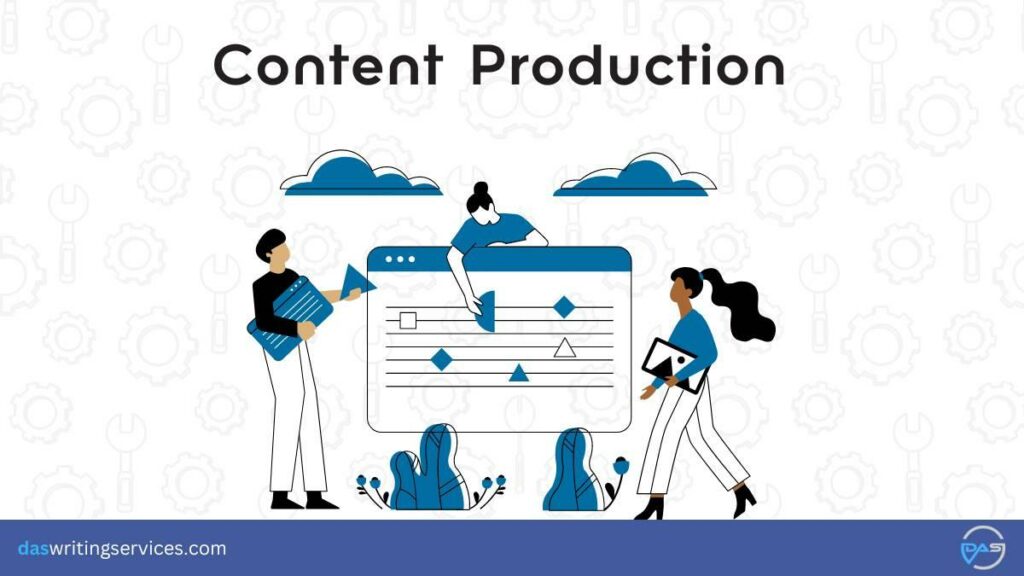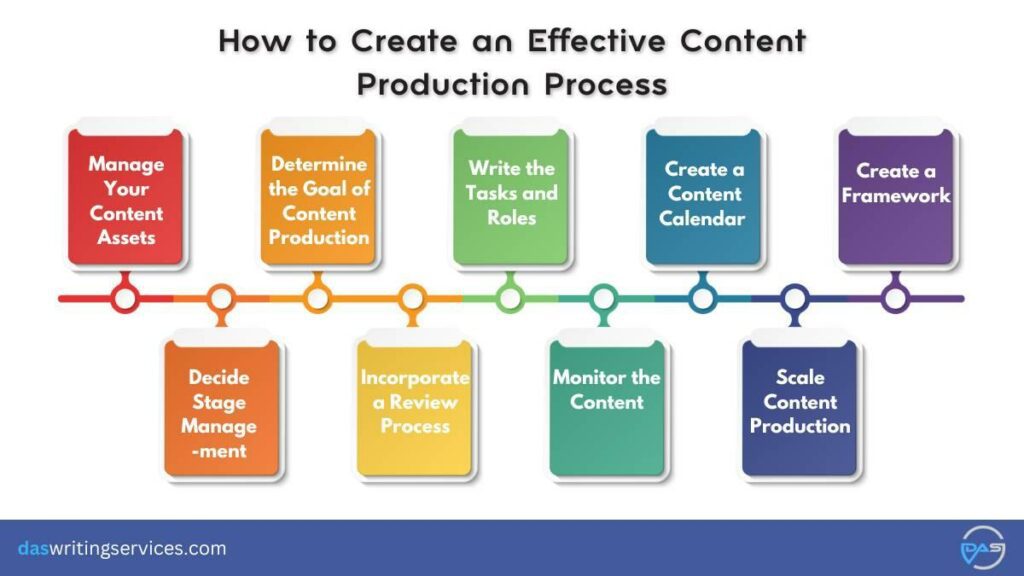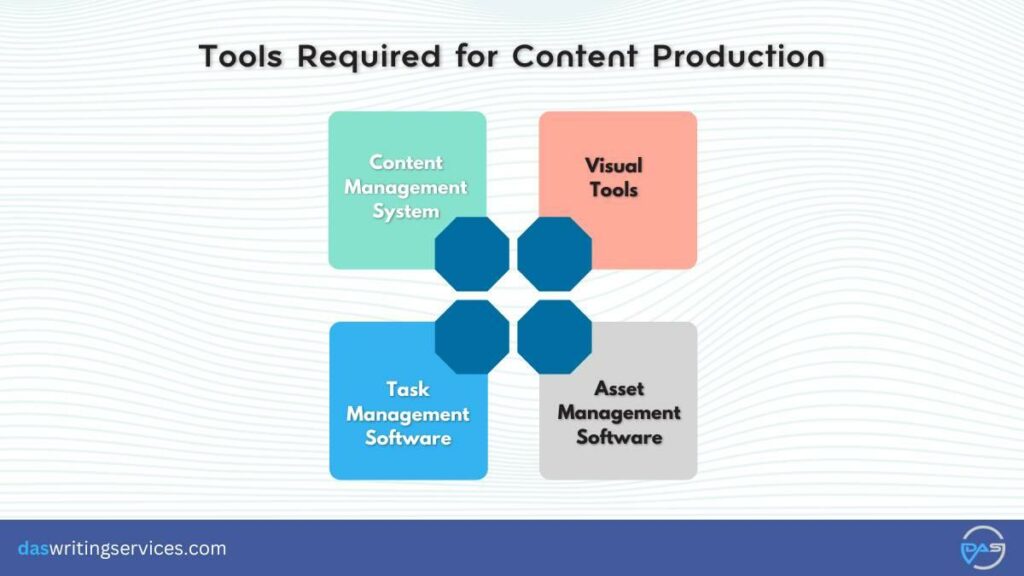Creating impactful content for touchpoints on the internet is crucial to engage more audiences. If you have a new business or website, by the help of effective content you can let your business grow faster. It will ensure that all the blogs and related articles get attention from the audiences.
Content production may seem like a straightforward process, but every team needs an organised process for creating content that will deliver results. Robust and a planned strategy for content creation can help you scale content, ensure consistent quality, and of course, achieve set objectives.
In this article, we will walk through the steps of creating an effective content production that will justify your content creation efforts.
What is Content Production?

Content production refers to the planning, creating and distribution of content to the target audiences. It covers the entire journey of content from initial ideation and conceptualisation to the final distribution.
This does not revolve around a single format or channel. Rather, it is about creating a diverse set of entertaining, educational, emotional, and commercially relevant content. Each of these plays a unique role in a content marketing strategy for the content that works properly in the SERP.
Additionally, distributing these contents across various platforms like social media, email newsletters, or on your website, ensures that the messages will reach the audience, where they are more receptive.
What are the Factors that Regulates Content Production?
There are mainly 6 factors that regulate a content production process:
- Set Your Goals: Your aims or objectives will define how you will approach the overall production of the content.
- Outline the Tasks: Make lists of every step of your content planning several tasks can ensure a seamless process without constant supervision.
- Assign the Roles: Assign individual responsibilities within your team to keep them accountable towards the content planning process.
- Formulate the Order: A specific order of tasks can help you identify the position of the content in its journey to completion.
- Timelines and Deadlines: Setting expected deadlines can ensure more productivity as less time will be consumed, and will stick to a frequent content output.
- Maintaining Content Inventory: Maintaining a content calendar for different contents across multiple distribution channels and verticals can help you focus on creating instead of searching every time while writing.
All these factors are crucial for an effective content production strategy for delivering faster results. We will uncover more details regarding each of these factors in the following sections.
How to Set an Effective Content Production Process?
Here is the step-by-step guide to the content production process:

#Step 1. Create Specific Cloud Storage for Content Assets
When investing in digital or content marketing, you must know that they include several assets. These include content, image video and audio. If you store all these assets in a disorganized way, it will be difficult for you to find those at the time of publishing the content.
This is why you need to get a cloud database where you can store all the content assets in one place.
#Step 2. Set a Goal for Content Production
Before you start the process of content production, you need to understand the purpose of content. You need to chalk out how all your content pieces fulfil the target audience’s requirements, answer their questions and resolve their doubts.
Your ultimate goal in content production should ideally be to build brand awareness, increase the rank of your web pages in the search results and thereby, boost your lead generation.
You can develop content map to plan out which content to write to address the queries of customers.
Mapping your content includes finding new topics through which you can create new content over a long period. It will also help you to allocate goals for each piece.
Furthermore, you can also divide these ideas by content types, projects and clients. It will assist you in prioritising your needs and potential value in the long term.
#Step 3. Define the Content Production Tasks and Roles
Before you start creating content, you must list every single requirement of that content.
Let’s assume that you are writing a blog, “How to Optimise Your Website for Technical SEO”. To make the content stand out, it is better if you create infographics, take screenshots of tools like Page Speed Insights.
Apart from this, you also need to set the roles of experts who will proofread, who will do fact-checking, who will publish, etc.
After the writers have written the content, the editors will proofread it and ensure that the quality is top-notch. Once the file is proofread, the project manager will ensure that the file is delivered on time to the client.
#Step 4. Create a Content Calendar
You must create a content calendar where you can list all your tasks, deadlines and task assignments. It will set a strategic guideline for your business and your requirements. To build your content calendar, you need to follow these steps:
- Determine the content requirements that are required to achieve your marketing goal. For instance, if you want more traffic to any particular product page, then you have to create more articles, blogs and videos related to that product.
- Do proper competitor analysis to understand their marketing strategy and understand where you can outrank them by providing more value to the audience.
- Analyse the market and SEO to make sure that you have created content on all relevant topics.
Occasional opportunities are one of the best options for creating content. For instance, you can create content on Christmas or other festivals on topics like ‘Best [keyword] for [year].
A content calendar will assist you in strategically outlining your requirements and reducing the time required for task completion. Furthermore, it will help you to spread out the tasks so that your skilled professional writers can get ample time to frame and polish the content.
You can watch the following video of Neil Patel to learn his steps to create a social media content calendar:
#Step 5. Create a Content Framework
The content production process requires creating a framework for each type of content. For instance, if you are writing an article or a blog, you need to stick to the following procedure:
- Research: Before writing content, you must do proper research on the topic and the target audience you are writing the content for. In addition, you must also research the keyword, its difficulty and its relevancy to your industry.
- Craft Content: Once you have the research, you need to write the content keeping the SEO guidelines, which will help it attain a better SERP ranking. You also need to include images, videos and infographics to make it more engaging to the target audience.
- Check Quality: Quality approval is crucial for every content. If the quality is top-notch, the audience will find it engaging and informative. An in-house team of editors are required to check the overall quality of the content according to your requirements.
- Choose Optimized Slug: A proper URL slug can help your content rank well on the search engine result page. It is better if you incorporate the keywords in the slug.
- Add Category/Hashtags: While publishing content, you need to set the category. In case it is social media content, you need to include proper hashtags. It helps you to distinguish the type of content you have crafted and the category it comes under. Further, it boosts the reach of content.
#Step 6. Incorporate a Review Process
You should include a content review or quality assurance process to make sure that all the content is having top-notch quality. With the help of an in-house editorial team, you can better review the quality of the content and fix issues like grammatical errors, factual mistakes, improper flow, etc.
In this regard, we would like to inform you that we have explained how to review content to get the maximum result for your business in a detailed manner. You can visit this blog to learn about the content review process.
What are the Tools Required for Content Production?
Content creation is time-consuming and requires a lot of research and analysis. However several tools can help you to complete the entire process of content creation seamlessly.
Here are the types of tools that are essential for content development:

1. WordPress: Content Management System
You can use a content management system software to create, modify, and store content online. It will help you to build a website without any technical knowledge. Heralded as the most popular CMS, WordPress powers more than 43% of websites globally.
- It is one of the most popular CMS and is known for its versatility and user-friendly features.
- Its intuitive interface helps you to manage your content effectively.
- WordPress allows multiple users with different roles and responsibilities to work together.
- Multiple customization options available to offer better user experience.
2. Canva and Visme: Visual Tools
Including ample visual cues are important to make the content more engaging. So to make images or other visuals you need different tools and software. This software will help you to create images and info graphics quickly.
- Used to create social media graphics, promotional merchandise, presentations, and postcards.
- Edits videos and photos properly with additional AI features.
- Creates graphic designs like info graphics, on-page templates, templates for presentations, and eye-catching 3D graphic designs.
- Both of these provide a free vast template library for various purposes like marketing materials and social media graphics.
3. Asana and Trello: Task Management Software
Task management software is generally used to view all the tasks of a particular project. It will help you to analyse the current content production process along with creating additional tasks. Asana and Trello are the two popular content production tools to manage and view all tasks properly. The main features of these two are as follows:
- Both of these software focus on project management, task management, collaboration and workflow automation.
- Offers features like task dependencies, subtasks, recurring tasks, and timelines.
- Easy to do more tasks between lists and track progress.
- Both provide comprehensive project management capabilities.
4. Google Drive: Asset Management Software
An asset management software will help you store all your digital content assets including images, videos, style guides, and other crucial documents in a single place. Handling multiple tasks or projects at a single time happens frequently during the content production process. Thus, asset management software is essential to ease the tasks.
- Provides the feature of cloud storage which syncs the files across any device (Smartphones, desktops, or laptops).
- Helps in the easy sharing of files or folders with access or permission by others( like edit, view, comment).
- Provides offline access which means you can easily access the file even if there is no internet connection.
- Has the feature of real-time collaboration on documents, spreadsheets, and presentations with multiple users.
5. Buffer: Content Distribution Software
Content distribution software helps in managing and sharing content with a wider audience. It helps in maximising the reach, engagement, and visibility of your website across various platforms. Buffer helps to share and distribute content across different platforms. It helps in increasing the rank of a website in the SERP by bringing more traffic.
- Can connect and operate multiple accounts from a single dashboard.
- Tracks social media performance, create reports and gains insights into audience engagement.
- Has the feature of a comment box, where you can manage comments and messages from all connected social media accounts in one place.
- Provides the feature of AI assistance to generate ideas and content repurposing.
6. Google Analytics: KPI Tracker Software
Google Analytics is a prominent tool for measuring the key performance indicators of a website. This is used by almost 55.49% of all websites that are present in Google. If you use certain CRM solutions, pairing them with GA4 can one up your game to track your website and campaign performances.
- It understands your website’s visitors, behaviour, demographics and interests.
- Helps in tracking the effectiveness of your website in achieving certain goals like purchases or sign-ups.
- It is specially designed to track various online store performances like transactions, revenue, and product sales.
- Additionally, it tracks specific user interactions on your website like clicks, video playtime, and form submissions.
Takeaway
Streamlining your content production process is essential for maintaining a solid online presence and enhancing business growth. A robust content production process requires collaboration, clear expectations and roles, deadlines, and timelines to plan content activities.
Implementing a proper content strategy will create a difference in your content output which will help you to attain a higher rank in the SERP. Distributing engaging and valuable content will help in reaching more organic traffic and generating leads.
Frequently Asked Questions
1. How to maintain a schedule for content production?
To maintain a schedule for content production, you need to define your goal and create a template for your content calendar. After that, you will be required to choose a channel and initiate with a calendar year. Then, you need to create content and update that content regularly to keep it evergreen.
2. What is a content strategy plan?
A content strategy plan is a regular practice of planning to generate, deliver and effective content related to a topic or group of topics. Through content strategy, you can ensure that each piece of content serves and assists its purpose.
3. What is a content planning tool?
Content planning tool assists marketers in creating, organising and efficiently managing their content. It helps marketers to create content calendars through which they can set up alerts and notifications. In addition, it helps them collaborate with their team members easily.





Leave a comment
All comments
Mark Haley
Great write-up, I’m normal visitor of one’s web site, maintain up the excellent operate, and I'm going to be a regular visitor for a lengthy time.